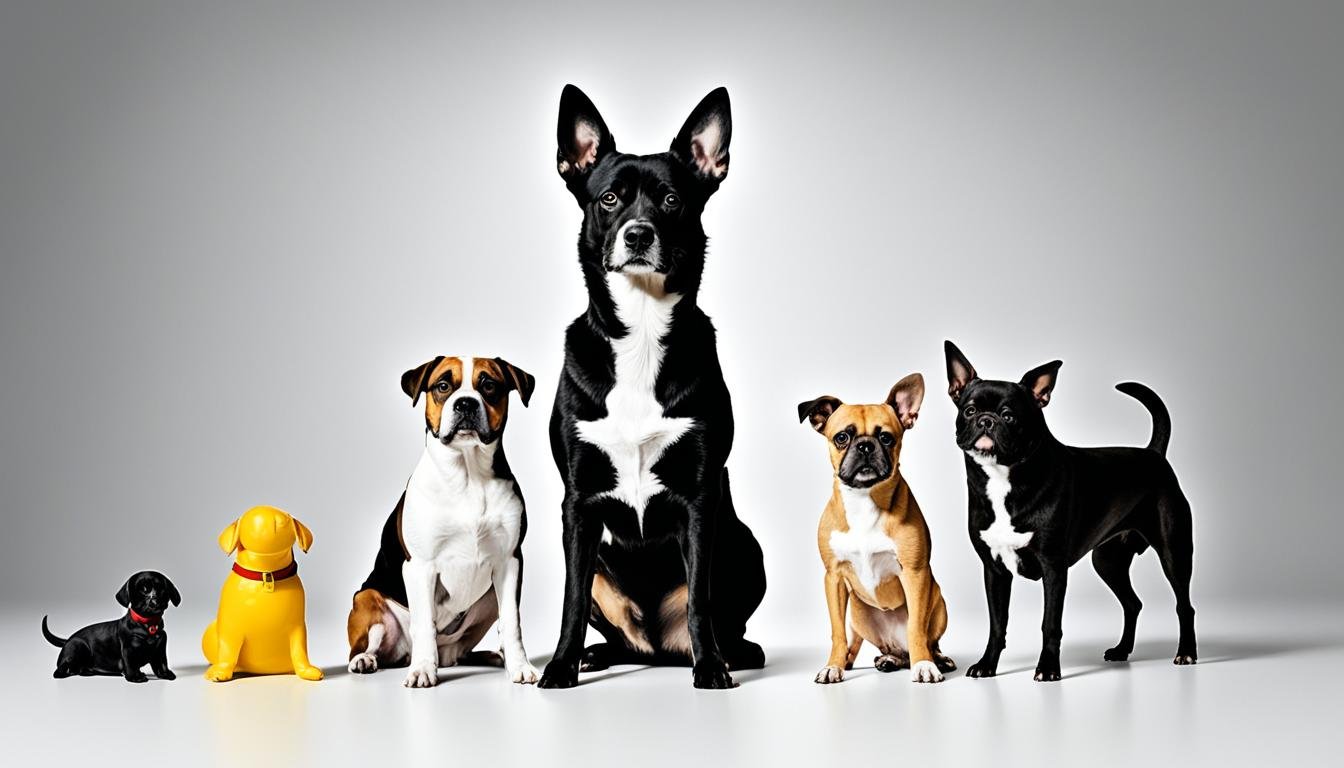Did you know that some dog breeds can weigh over 200 pounds1? These giant-sized companions are vastly different from the tiny Chihuahuas and Yorkies that many people picture when they think of “man’s best friend.” Knowing whether your canine companion is a small, medium, large, or giant breed is crucial, as each size category has unique care requirements. This comprehensive guide will help you determine if your dog is considered a large or giant breed, so you can ensure they get the appropriate diet, exercise, and accommodations.
Key Takeaways
- Dog sizes range from tiny Toy Poodles to massive Great Danes.
- The most accurate way to determine your dog’s size is by checking its weight.
- Small, toy, and miniature breeds weigh between 1-10 kg1, while medium-sized dogs are 11-26 kg1.
- Large breed dogs typically weigh 26-44 kg1, and giant breeds are 45 kg or more1.
- Giant breeds take 18-24 months to reach adulthood and grow very rapidly in the first five months1.
Understanding Dog Size Categories
When it comes to dogs, size matters – both in terms of their physical characteristics and the specialized care and feeding they require. Canine size categories are defined by several key factors, including a dog’s weight, height, and overall build2. These size distinctions play a crucial role in determining the appropriate pet food, bedding, collars, and other essential accessories for your furry friend.
Small, Toy and Miniature Breeds
Small, toy, and miniature dog breeds typically weigh less than 20 pounds2. This category includes popular pint-sized pups like Chihuahuas, Toy Poodles, and Miniature Schnauzers2. While these diminutive dogs may be adorable, their small size brings unique challenges. They tend to have high energy levels and require specialized diets and care to maintain optimal health2. Additionally, their compact size can make them prone to skin irritation and weight gain if their indoor-focused lifestyles are not properly managed.
Medium Breeds
Medium-sized dogs, on the other hand, generally weigh between 20 to 50 pounds2. Breeds like Staffordshire Bull Terriers, Australian Cattle Dogs, and British Bulldogs fall into this category2. While many medium breeds are known for their high energy, the more sedentary lifestyles of their owners can lead to weight gain and health issues2. Maintaining a balanced diet and regular exercise is crucial for these pups to thrive.
| Size Category | Weight Range | Bed Dimensions | Collar Width | Neck Circumference | Back Length (Sweater) | Chest Circumference (Sweater) | Base of Neck (Jacket) | Chest (Jacket) | Strap Width (Harness) |
|---|---|---|---|---|---|---|---|---|---|
| Extra-Small (XS) | Up to 15 lbs | 20″ x 30″ | 5/8″ | 8-11″ | 9-12″ | 12-14″ | 10-15″ | 12-17″ | 5/8″ |
| Small (S) | Up to 20 lbs | 20″ x 30″ | 5/8″ | 12-15″ | 13-15″ | 14-17″ | 12-18″ | 14-20″ | 5/8″ |
| Medium (M) | Up to 50 lbs | 27″ x 36″ | 3/4″ | 15-18″ | 16-19″ | 17-21″ | 16-22″ | 17-24″ | 1″ |
| Large (L) | Up to 70 lbs | 35″ x 45″ | 1″ | 18-22″ | 19-23″ | 21-25″ | 19-26″ | 21-29″ | 1″ |
| Extra-Large (XL) | Up to 80 lbs | 35″ x 45″ | 1″ | 18-26″ | 22-29″ | 26-32″ | 20-33″ | 23-37″ | 1″ |
The table above provides a comprehensive overview of the key size categories for dogs, including weight ranges, bed dimensions, collar widths, neck circumferences, and measurements for dog sweaters, jackets, and harnesses3. Understanding these detailed specifications can help pet owners select the appropriate accessories and ensure their canine companions are comfortable and well-equipped.
Is my dog large or giant breed?

When it comes to dog sizes, understanding the difference between large and giant breeds is crucial for providing your furry friend with the proper care and nutrition4. Large dog breeds typically weigh between 55-90 pounds, while giant dog breeds are classified as those that weigh around 90 pounds or more, with some considered giants once they reach 100 pounds or more4.
Some common examples of large dog breeds include Labradors, Golden Retrievers, Rottweilers, and Rhodesian Ridgebacks4. These larger dogs require specialized diets that cater to their increased size, slower metabolisms, and high exercise needs, often focusing on promoting bone, joint, and digestive health4.
On the other hand, giant dog breeds, such as Great Danes, Bullmastiffs, Newfoundlands, and Dogues de Bordeaux, have even more specific dietary requirements4. These gentle giants need high-quality, easy-to-digest foods to prevent digestive issues, and their rapid growth during the first five months requires a nutrient-rich diet4.
| Dog Size Category | Weight Range | Lifespan | Common Health Concerns |
|---|---|---|---|
| Large Breeds | 55-90 pounds | 8-10 years | Hip/elbow dysplasia, arthritis, wobbler syndrome, dilated cardiomyopathy, cherry eye |
| Giant Breeds | 90+ pounds | 8-10 years | Hip/elbow dysplasia, arthritis, bloat (GDV), dilated cardiomyopathy |
Regardless of whether your dog is a large or giant breed, it’s essential to monitor their growth, provide appropriate exercise, and ensure they receive a balanced diet to support their specific needs45. With the right care and attention, you can help your large or giant breed dog thrive and enjoy a healthy, happy life45.
“Owning a large or giant breed dog requires a unique set of considerations, from their dietary needs to their potential health concerns. As a responsible pet parent, it’s crucial to educate yourself and provide the best possible care for your furry friend.”
Conclusion
Determining whether your dog is a large or giant breed is crucial for providing the right care, diet, and environment. By using your dog’s weight and height measurements, you can accurately identify its size category and ensure you meet its specific needs6. Purebred Great Pyrenees can weigh up to about 120 pounds for males, and giant breed dogs like Great Pyrenees and Great Danes are often used as therapy dogs due to their empathy7. The minimum recommended fence height for larger dogs is 5 to 6 feet, and larger dog breeds can have a lifespan as short as 7 or 8 years.
8 Large dog breeds generally have good health ratings, with fewer genetic health problems compared to smaller breeds, and are known to be great family pets, being loyal and loving towards family members7. Large breeds can have higher food expenses and produce larger quantities of waste, and some large breeds are known for slobbering, requiring strategic placement of water bowls to prevent floor damage6. Guest reactions to giant dogs attempting to be lap dogs can vary, and they can act as personal heaters, both in winter for warmth and in summer causing discomfort.
6 Drive-thru workers, delivery personnel, and neighbors might find giant breed dogs intimidating due to their size, and they can be playful in a rough manner, as their strength can handle vigorous games like tug of war6. Accidents can occur with giant dogs not realizing their strength, potentially causing unintentional harm, and they are hypersensitive to the presence of small children6. Cute behaviors of giant dogs can be magnified due to their size, making them popular at puppy daycare and garnering attention in public, but they also produce more significant waste, hairballs, and drool compared to smaller breeds.
FAQ
What are the main dog size categories?
The main dog size categories are small/toy/miniature (1-10 kg), medium (11-26 kg), large (26-44 kg), and giant (45 kg or more).
What are the characteristics of small, toy, and miniature breeds?
Small, toy, and miniature breeds typically weigh between 1-10 kg. This includes popular breeds like Chihuahuas, Toy Poodles, and Miniature Schnauzers. These smaller dogs have high energy levels and require specialized diets and care. They are prone to skin irritation and weight gain due to their indoor-focused lifestyles.
What are the characteristics of medium-sized dog breeds?
Medium-sized dogs usually weigh 11-26 kg and include breeds like Staffordshire Bull Terriers, Australian Cattle Dogs, and British Bulldogs. Many medium breeds have high energy but are living more sedentary lifestyles, so they need a healthy diet and regular exercise to maintain a healthy weight.
How do I know if my dog is a large or giant breed?
Larger breeds like Labradors, Golden Retrievers, Rottweilers, and Rhodesian Ridgebacks typically weigh 26-44 kg. Giant breeds weigh 45 kg or more and include Great Danes, Bullmastiffs, Newfoundlands, and Dogues de Bordeaux. Use your dog’s weight and height measurements to determine its size category.
What are the special considerations for large and giant breeds?
Larger and giant breeds require specialized foods that promote bone, joint, and digestive health due to their increased size, slower metabolisms, and high exercise needs. Giant breeds’ rapid growth in the first 5 months requires a nutrient-rich diet to prevent issues.
Why is it important to know if my dog is a large or giant breed?
Knowing whether your dog is a large or giant breed is important for providing the right diet, exercise, and care to keep your pup healthy. Consult your veterinarian if you have any concerns about your dog’s size and growth.







